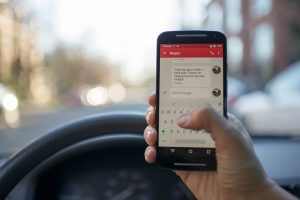 Most states in the U.S. have adopted strict distracted driving laws that limit or prohibit the use of handheld devices while driving. Some laws are so strict that they don’t even allow a driver to touch the screen of their GPS while driving. Although, everyone does it anyway.
Most states in the U.S. have adopted strict distracted driving laws that limit or prohibit the use of handheld devices while driving. Some laws are so strict that they don’t even allow a driver to touch the screen of their GPS while driving. Although, everyone does it anyway.
The stats on distracted driving are scary. According to the Department of Transportation, each year, distracted drivers cause 1,600,000 accidents, 500,000 injuries, and 6,000 fatalities.
According to the National Highway Traffic Safety Administration (NHTSA), it’s estimated that 481,000 people use cellphones while driving during the day.
With these high numbers, you’d expect public transportation operators to take extra care since they’re carrying multiple passengers, but that’s not always the case. It’s common to see bus drivers talking on cellphones and texting just like motorists. Although you can’t see them, many pilots, along with train and light rail operators, do the same. When they do, they put more people’s lives in jeopardy.
The rules are different for injuries caused by public transit accidents
Distracted public transit operators are a danger to society, but when they cause an accident, the damage is far-reaching. For example, a distracted driver operating a passenger vehicle might only injure or kill one or two people in a crash. A distracted bus driver, however, can potentially kill and injure twenty to thirty people, depending on how many passengers they’re carrying and how many passenger vehicles they strike.
Next to their injuries, the biggest problem facing victims of these crashes is not knowing the rules for filing a personal injury claim. In most states, the statute of limitations for personal injury claims is two to three years. When the accident involves public transportation, that time limit doesn’t always apply. Victims of mass transit crashes caused by distracted operators, like the Amtrak derailment near Tacoma, Washington, are sometimes unfairly denied the right to file a claim simply because they unknowingly waited too long.
In New York, for example, if you’re involved in an accident involving city-run mass transit, you’ll need to file a claim against a government entity, usually the Metropolitan Transit Authority (MTA). The statute of limitations for personal injury involving mass transit is 90 days. That’s not much time. If you don’t file a claim within that time frame, you can lose the right to file a claim.
Today’s “selfie culture” is distracting to pilots of small planes
Although it’s speculation that a deadly Cessna plane crash in Denver, Colorado was caused by a distracted pilot taking selfies, it’s a likely possibility. The pilot, 29-year old Amritpal Singh, took off at night with a single passenger. He was using a flash and taking selfies with a GoPro camera just before his plane stalled and crashed. He did not meet the requirements for flying at night with passengers, which would have made any slight distraction a dangerous situation.
Commercial airline pilots have also been known to put passengers at risk by consuming alcohol, flying while on prescription medication, and while sleep-deprived. Taking selfies while flying a small plane is not a good idea, but selfie-obsession is inherent in today’s culture.
It’s an unfortunate fact that many of today’s teenagers and even adults have acquired an addiction to taking selfies, text messaging, and posting on social media. This addiction doesn’t just isolate people at the dinner table. It robs people of their lives.
Curbing the distraction with laws is not enough
Laws already exist that prohibit people from driving and texting, but people do it anyway. Most people do it anyway because think they can get away with it. For a long time, they do. Until one day, they either become the victim of a distracted driving accident, or they cause an accident.
For some, the stories of people who survived horrendous crashes are the only reason they make a conscious choice not to pick up their phone while driving. It’s hard to text and drive when you meet someone who survived a crash but was left paralyzed and disfigured.
Perhaps public transportation operators get away with distracted driving because they’re harder to spot. Police can’t pull over an Amtrak train if they see the operator using their cellphone. Trains move so fast it’s unlikely that anyone would notice a distracted operator to begin with.
The best way to stop public transportation operators from driving while distracted is to do two things. First, crack down hard on everyone who is caught, and two, raise awareness of the consequences and hope they’ll make the right choice.
Photo Credit
Photo is pixabay creative commons
Guest Author Bio
Jamie Lansley
Jamie is a freelance writer who covers trends in business, technology, and health. She loves to go skiing, camping, and rock climbing with her family.


Please Share Your Thoughts - Leave A Comment!